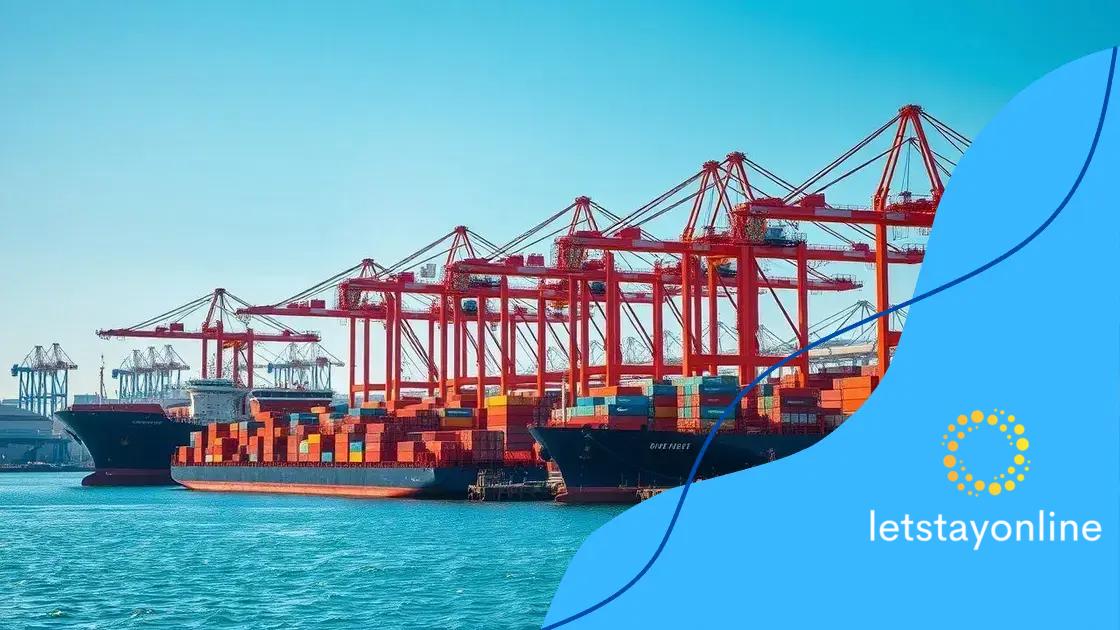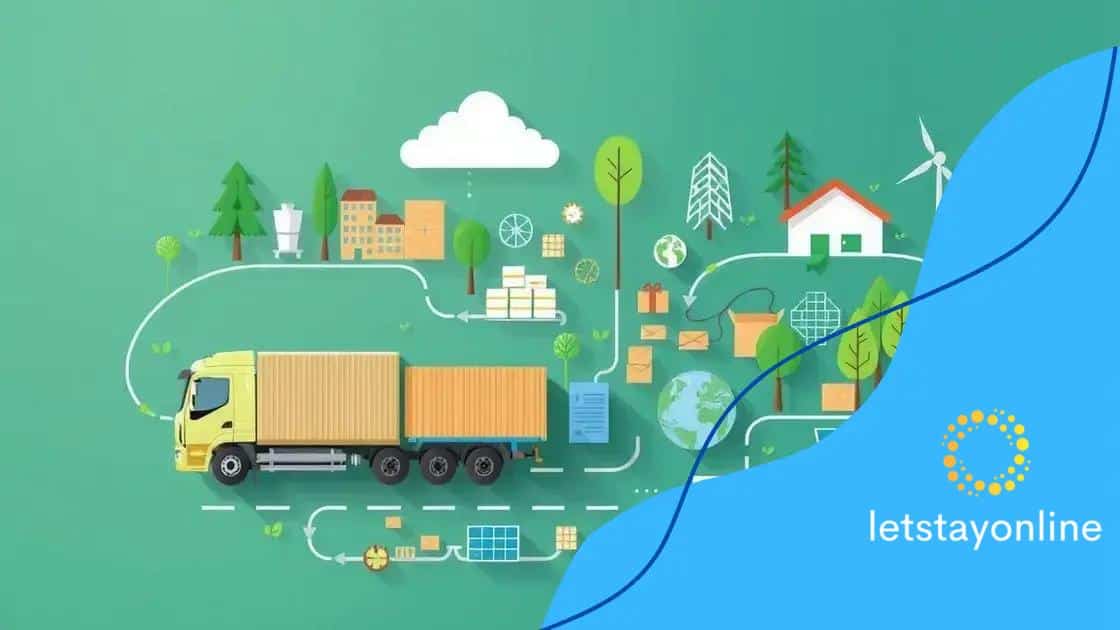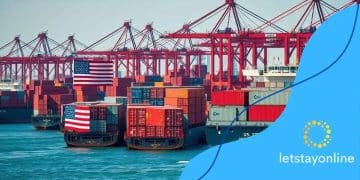How the global supply chain is evolving in 2025

In 2025, the global supply chain is evolving through increased digital trade, a focus on sustainability, technological advancements, and shifts in production locations to enhance efficiency and meet consumer demands.
How the global supply chain is evolving in 2025 is a topic that sparks curiosity among businesses and consumers alike. With rapid advancements and shifts in the global market, understanding these changes can shape strategies for success. What does the future hold for your supply chain?
Key trends shaping global supply chains
Understanding the key trends shaping global supply chains is essential for businesses looking to thrive in 2025. These changes reflect advancements in technology, shifts in consumer behavior, and demands for sustainability.
Digital Transformation
The rise of technology profoundly impacts supply chains. Companies are integrating advanced technologies like artificial intelligence and cloud computing to improve efficiency. With these innovations, they can analyze data in real-time and respond faster to market changes.
Moreover, automation is gaining ground. Many businesses are investing in robotics and automated systems to streamline operations and reduce human error.
Sustainability Focus
Consumer awareness about environmental issues is growing. More customers prefer brands that practice sustainability. As such, companies are taking steps to make their supply chains greener. This includes using eco-friendly materials and reducing carbon footprints.
- Implementing sustainable packaging solutions
- Optimizing transportation routes for fuel efficiency
- Partnering with sustainable suppliers
Additionally, companies are embracing circular economy principles by recycling materials and minimizing waste. Consumers value transparency, so sharing sustainability efforts is crucial.
Geopolitical Factors
Global events, such as political unrest or trade agreements, can significantly impact supply chains. Businesses must stay agile to adapt to these changes. Establishing diversified suppliers can help mitigate risks related to disruption.
Forming strategic partnerships across borders also benefits companies, allowing them to leverage local knowledge and resources.
Overall, the future of global supply chains hinges on addressing these trends. Awareness and adaptation are crucial for success in this evolving landscape.
Impact of technology on logistics
The impact of technology on logistics is profound, transforming how businesses operate. Technology enables faster and more accurate processes, aligning with today’s demands for efficiency and reliability.
Automation in Warehousing
Automated systems are streamlining warehouse operations. Robotic arms and conveyor belts are minimizing manual labor and increasing speed. By utilizing these systems, companies can significantly reduce error rates and improve productivity.
- Robots picking and packing orders efficiently
- Automated inventory tracking systems
- Drones delivering products in urban areas
Such innovations not only enhance productivity but also allow employees to focus on higher-value tasks, which can be more rewarding.
Data Analytics for Better Decision Making
Data analytics is a game changer for logistics. By processing vast amounts of data, companies can uncover insights that improve operations. This includes predicting demand more accurately and optimizing routes.
Real-time data allows businesses to adjust their operations quickly. For example, if there is a sudden change in demand, companies can react by reallocating resources effectively. Machines powered by Artificial Intelligence (AI) play a critical role in making sense of this data.
Moreover, the ability to monitor transportation systems gives supply chain managers valuable information about delivery statuses. This transparency enables better communication with customers.
Incorporating technology also means companies must adapt to challenges, such as data security and privacy concerns. However, the benefits often outweigh these risks, leading to safer, quicker, and more efficient logistics solutions.
Sustainability efforts in supply chain management

Sustainability efforts in supply chain management are becoming increasingly vital as companies strive to meet consumer demands and regulatory standards. Businesses are evaluating their operations for environmental impact, making significant changes to promote a greener future.
Eco-Friendly Sourcing
Companies are focusing on eco-friendly sourcing to ensure that raw materials come from sustainable sources. This means choosing suppliers who practice responsible harvesting and production. By prioritizing sustainable materials, businesses can reduce their overall environmental impact.
- Utilizing biodegradable materials wherever possible
- Partnering with suppliers committed to renewable resources
- Enhancing recycling programs for better raw material recovery
When companies adopt these practices, they not only protect the environment but also appeal to a more conscious consumer base.
Energy Efficiency in Logistics
Improving energy efficiency in logistics operations is another key focus area. This can involve optimizing routes to reduce fuel consumption, utilizing energy-efficient vehicles, and adopting renewable energy sources in warehouses and distribution centers.
For instance, businesses that convert their fleet to electric vehicles can significantly lower their carbon emissions. Additionally, implementing energy management systems helps to monitor and control energy usage effectively.
Integrating technology is essential in achieving these sustainability goals. Advanced analytics can help identify areas for improvement, allowing companies to make informed decisions that support their sustainability initiatives.
Overall, the commitment to sustainability not only benefits the planet but also enhances brand reputation. Companies that actively promote their green initiatives can attract customers who value corporate social responsibility, leading to lasting loyalty.
Challenges in adapting to new supply chain models
Adapting to new supply chain models presents significant challenges for businesses. As the landscape evolves, these hurdles require careful navigation to ensure continued success and efficiency.
Technological Integration
One major challenge businesses face is integrating new technologies into existing systems. While innovations like automation and AI can enhance efficiency, they also necessitate comprehensive training for staff. Companies must ensure that employees are not only familiar with the new tools but can effectively use them to maximize benefits.
- Overcoming resistance to change within the organization
- Ensuring data security when adopting new systems
- Achieving seamless communication between legacy systems and modern technology
Failure to address these aspects can lead to disruptions and reduced productivity.
Supply Chain Visibility
Another challenge is achieving visibility across the supply chain. As businesses become more complex, tracking products in real-time becomes essential. Without proper monitoring systems, companies may struggle to identify issues promptly. This lack of visibility can result in delays and missed opportunities.
To enhance visibility, organizations must implement advanced tracking technologies. This might include deploying IoT devices or utilizing data analytics for better insight. The goal is to create a transparent supply chain that can adapt quickly to market demands.
Logistical constraints also play a significant role in adapting to new models. As global trade fluctuates, factors such as transportation delays and rising costs can impact supply chains negatively. In response, companies might need to rethink logistics strategies to ensure timely delivery and cost-effectiveness.
Ultimately, while the transition to new supply chain models can be challenging, addressing these issues head-on can lead to a more resilient and efficient operation. Strong leadership and a commitment to continuous improvement are crucial during this period of change.
Future predictions for global trade dynamics
Future predictions for global trade dynamics indicate significant shifts influenced by technology, policy changes, and consumer behavior. Understanding these changes is crucial for businesses aiming to thrive in an evolving marketplace.
Increased Digital Trade
The rise of e-commerce is driving a rapid increase in digital trade. As more consumers shop online, businesses must adapt their supply chains to meet this demand. This shift may lead to a surge in cross-border transactions done through digital platforms. Besides convenience, digital trade offers lower costs and faster delivery, which consumers are increasingly expecting.
- Expansion of international e-commerce platforms
- Improved logistics to support swift deliveries
- Greater emphasis on cybersecurity to protect transactions
Companies that embrace these changes will be better positioned to reach global markets.
Shifts in Global Supply Chain Locations
Another key prediction is the potential reshaping of global supply chains. Businesses may start relocating manufacturing closer to their customer bases. This trend, known as nearshoring, can enhance responsiveness and reduce transportation costs. Factors such as political instability, rising tariffs, and the impacts of the pandemic are prompting companies to reconsider the locations of their operations.
Moreover, businesses will likely invest in automation and smart technologies to help counteract labor shortages and improve efficiency.
Changes in regulations and trade policies in major economies, like the United States and China, will continue to impact global trade dynamics. Tariffs, trade agreements, and sustainability initiatives will also play a crucial role in shaping the landscape.
Finally, consumers are showing a growing preference for sustainability. As awareness of environmental issues increases, businesses that prioritize sustainable practices may gain a competitive advantage. This shift will influence product sourcing, transportation methods, and overall supply chain management.
FAQ – Frequently Asked Questions about Global Supply Chain Dynamics
What are the key trends influencing global trade in 2025?
Key trends include the rise of digital trade, shifts towards sustainability, and changes in supply chain locations as companies seek efficiency.
How does nearshoring impact global supply chains?
Nearshoring allows companies to move production closer to their customers, improving responsiveness and reducing shipping costs.
Why is sustainability important in supply chain management?
Sustainability is crucial as consumers increasingly prefer eco-friendly practices, pushing companies to adapt for better market position.
What role does technology play in modern supply chains?
Technology enhances efficiency, provides real-time tracking, and supports better decision-making through data analytics, enabling companies to adapt swiftly.






